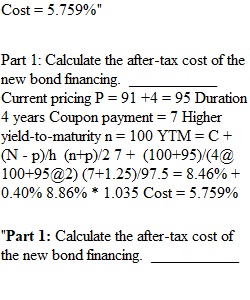


Q Create an Excel spreadsheet to organize your answers to the following problem, and submit your Excel file as an attachment by clicking on the appropriate button on this page. A firm that is in the 35% tax bracket forecasts that it can retain $4 million of new earnings plans to raise new capital in the following proportions: 60% from 30-year bonds with a flotation cost of 4% of face value. Their current bonds are selling at a price of 91 (91% of face value), have 4 years remaining, have an annual coupon of 7%, and their investment bank thinks that new bonds will have a 40 basis point (0.40%) higher yield-to-maturity than their current 4-year bonds due to their longer term. Any new bonds will be sold at par. 10% from preferred stock with a flotation cost of 5% of face value. The firm currently has an outstanding issue of $30 face value fixed-rate preferred stock with an annual dividend of $2 per share, and the stock is currently selling at $27 per share. Any newly issued preferred stock will continue with the $30 par-value, and will continue with the $2 dividend. 30% from equity. Their common dividend payout ratio is 60%, they paid a dividend of $1.59 per share yesterday, the dividend is expected to grow to $4.22 in 20 years, and is expected to continue this growth rate into the foreseeable future. The common stock has a current market price of $19, and their investment banker suggests a flotation cost of 7% of market value on new common equity. Part 1: Calculate the after-tax cost of the new bond financing. ___________ Part 2: Calculate the after-tax cost of the new preferred stock financing. ______ Part 3: Calculate the after-tax cost of retained earnings financing. _______ Part 4: Calculate the after-tax cost of the new common equity financing. ______ Part 5: Calculate the company's WACC using retained earnings as the source of equity. __________ Part 6: Calculate the break point in the cost of capital schedule due to running out of retained earnings. __________ Part 7: Calculate the company's WACC after it substitutes the new common stock issue for retained earnings after it runs out of retained earnings. _________ Part 8: If the bonds had an after tax cost of 5.2% rather than the number you calculated in part #1 above, what would be the WACC using retained earnings as the source of equity? Part 9: If you have done the calculations above correctly, the after-tax cost of debt for this company is lower than the cost of equity when using retained earnings as the equity source. Explain why raising capital by borrowing is less costly than using your own funds on which you do not have to pay any interest at all. Part 10: Briefly explain the conceptual difference between the after-tax cost of retained earnings and the after-tax cost of new common stock. PreviousNext
View Related Questions